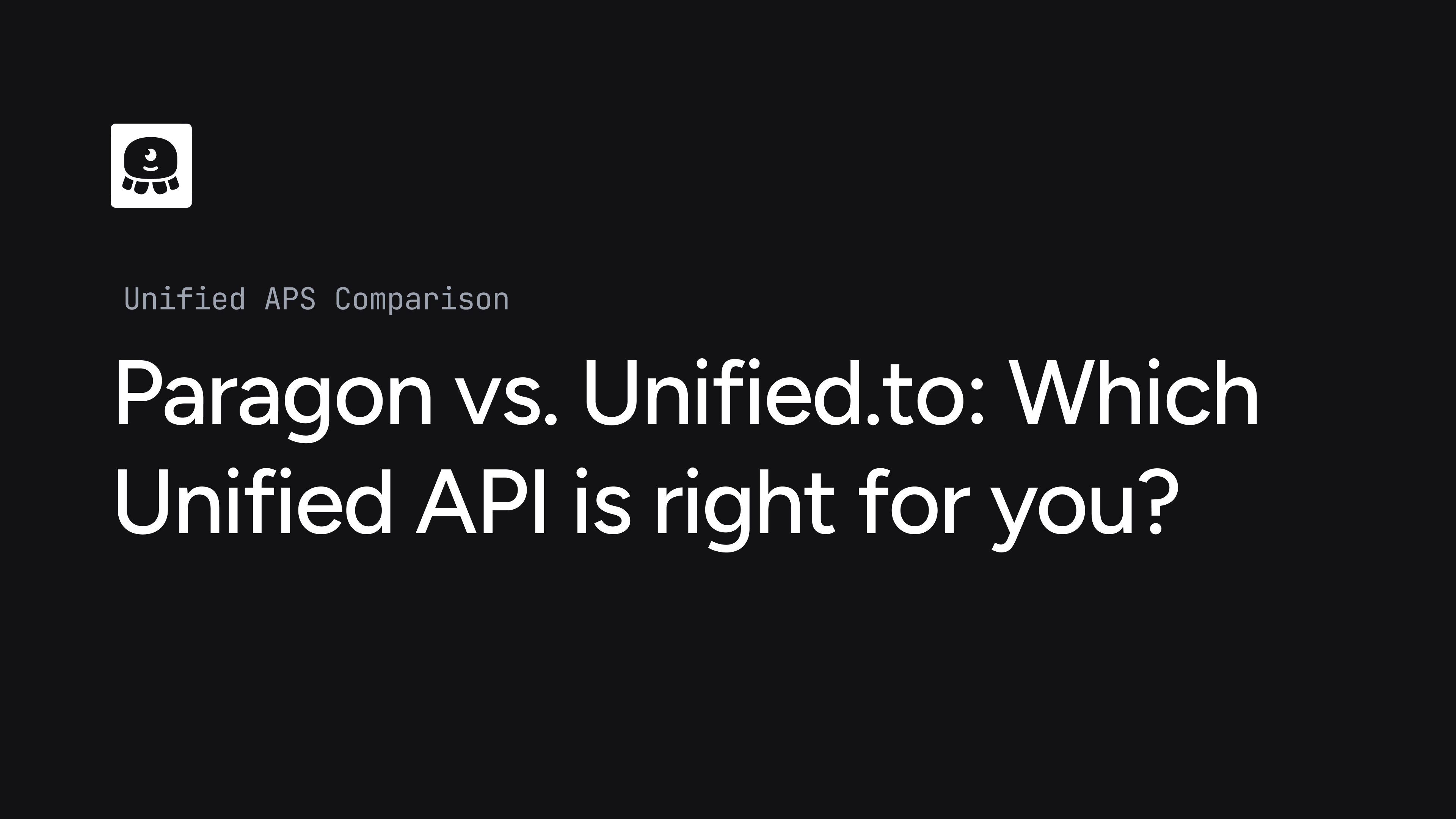Paragon vs. Unified.to:
May 21, 2025

Paragon helps teams build embedded integrations using polling, workflows, and webhooks. But if you need real-time data, normalized schemas, or AI-native infrastructure, you'll hit limits quickly.
Unified.to is built for what's next: a unified API platform designed for AI-first teams, real-time pipelines, and full control—and security—of your data architecture. Unlike Paragon, we never store end-customer data. You get fresh, real-time information without security liability.
At a Glance: Unified.to vs Paragon
Paragon helps teams build integrations with workflows and polling. Unified.to is built for products that depend on real-time data, clean schemas, and secure delivery.
Unified.to offers:
- Clean, normalized data across 270+ APIs
- Real-time updates with zero polling logic
- Database-ready delivery for AI pipelines
- No customer data stored ever
- Declarative, developer-first architecture
Here's a deeper look at how the two platforms differ, especially if your product depends on real-time data, normalized schemas, and secure delivery.
Real-time delivery without polling or custom sync logic
Paragon simulates real-time using polling, webhooks, and workflows. But making it work reliably means fallback logic, CRON jobs, and retries.
Unified removes that complexity. It delivers updates using native webhooks or scheduled virtual webhooks. Data arrives in a cleaned, normalized schema. Whether powering agents, dashboards, or in-app insights, it's current by default.
Normalized schemas across 270+ APIs—no per-connector mapping
Paragon exposes raw APIs. Calling Salesforce returns Salesforce data. Calling HubSpot returns something else. You're left to normalize, clean, transform, and reconcile it all.
Unified.to gives you a unified model.
Data from 270+ integrations flows into consistent, normalized structures organized by object type—with standardized fields, enums, and associations. No more conditional logic or edge-case cleanup per provider.
"Without robust integrations, we were being discounted right away." — Steve Hockey, CEO, MyHub
MyHub scaled to 60+ integrations with just one engineer using Unified's declarative model. A connector-based approach would've taken far more time. Unified handles the translation so your team can focus on product.
Clean data pipelines for RAG, agents, and embeddings
Paragon connects to apps but leaves AI prep to you—workflows, transforms, vector store ingestion.
Unified.to delivers ready-to-ingest data.
Its data model is AI-ready. Stream structured records from CRMs, ATSs, and HR platforms directly into Postgres, Mongo, or vector DBs using Database Sync. Event and historical data align under one schema. No ETL.
Unified delivers real-time context your models need: from support tickets to file contents and knowledge base pages.
Zero data stored—no compliance risk or vendor lock-in
Paragon stores customer data in its infrastructure. Tokens, logs, and metadata, including workflow state, live in their database.
Unified.to doesn't store end-customer data. Requests are proxied in real time from source to destination. No caching. No persistence.
You stay in control.
Data portability is built in. Query via API, subscribe via webhook, or stream directly into your database. One schema. No rewrites. No lock-in.
Built for developers, not just workflow builders
Paragon relies on a visual builder, task logs, and workflow controls. But that doesn't scale cleanly when logic spans connectors, mappings, and UI states.
Unified gives developers clean primitives.
With SDKs, full API coverage, and a plug-and-play Connect Component for auth, you integrate once and scale across every system. No guessing webhook shapes. No duplicating logic.
Unified is highly rated on G2 for support and developer experience.
"We didn't need to write custom code. Our engineers focused on product, not maintenance." — Founder, Sync2Hire
Sync2Hire launched production-ready HRIS and ATS integrations in days using Unified's architecture.
This is infrastructure that moves with your roadmap.
TL;DR — Unified.to vs Paragon
| Feature | Unified.to | Paragon |
|---|---|---|
| Data model | Fully normalized schemas across 270+ integrations | Per-connector models with no unified schema |
| Real-time support | Native + virtual webhooks, zero polling logic required | Webhooks + high-frequency polling via custom workflows |
| AI readiness | Built-in support for RAG, LLM pipelines, and vector DB sync | Supports AI use cases via ActionKit, but requires custom workflows |
| Database delivery | First-class Database Sync (Postgres, Mongo, etc.) with real-time + historical data | No native DB sync—manual workflow setup required |
| Data storage | Zero-data architecture, no caching or credential storage | Stores tokens and logs in cloud mode; on-prem available |
| Developer experience | SDKs, Connect Component, unified API, consistent models | Workflow builder, Connect SDK, flexible but fragmented data access |
| Scalability | Declarative, multi-tenant model with shared schema | Workflow-driven, per-customer configurations |
| Positioning | Real-time unified API for AI-native SaaS | Embedded iPaaS for building user-facing integrations |
| Pricing | Transparent, usage-based tiers | Custom quotes based on customer count and usage |
| Best For | Teams building AI features, live products, or normalized data pipelines | Teams building integration catalogs, embedded UIs, or flexible workflows |
View in-depth integration technology comparison
Unified.to gives you real-time data, normalized schemas, and full control. If you're building copilots, agents, or data-driven features—start here.
Start your free 30-day trial or talk to our team to see how fast you can go from connector to capability.
